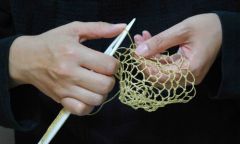What is [Freestyle fishnet knotting] ?
"Netting-needles" are a tool for knotting fishing nets, and have been used traditionally and worldwide wherever people catch fish with nets. In modern Japan, they are not used for making new nets so often anymore but are still needed for mending old ones and other purposes.
I advocate the "Freestyle fishnet knotting" for creating things with netting-needles and a variety of strings. Once you learn a set of basic steps, you can work on your own creation by tying one knot after another while controlling its size and shape. What is good about this technique is each knotter can easily give some ingenuity to express their intent and uniqueness. With some strings and a netting-needle at hand, you can make your own work anytime and anywhere.


I happened to have an opportunity to be taught this knotting technique in 1999’s Laos while visiting the region to research backstrap looms. Netting needles are widely seen in southwestern China and Southeast Asian countries, and have also been used in Japan’s fishing sites to attach lines to glass floats --- the knots tied with this technique can be adjusted to fit and fix the spherical floats.
For "Freestyle fishnet knotting", you can choose to use various types of strings made of hemp, cotton, recycled fiber, metal and so on. I’ve found strings with higher tension tend to make a good material. How you tie knots also make a difference --- aligned knots would give the finish a neat and orderly impression while irregular ones a unique savor. You can make bags, accessories, green curtains and other things for different uses or purposes.
There is one thing I feel worried about the technique. It has been gradually getting forgotten. I believe that the human race would lose something very precious if we fail to inherit this root technique which is simple but full of potential for free and unique expressions.
I have been engaged in the "Freestyle fishnet knotting" activities since 2008, giving workshops, exhibitions and other firsthand experiences. I hope I could help the technique become as widespread and popular as crocheting is. I've had my booklet on "freestyle fishnet knotting" published in English and Japanese for those I can’t reach face to face. It illustrate in two ways so that both right-handers and left-handers can learn the technique easily. (I am currently looking for exhibition/workshop organizers.)


When the Great East Japan Earthquake hit the Tohoku area in March 2011, I was so shocked at the fact that the tsunami, which destroyed people’s everyday lives, came from the normally-gracious-and-peaceful ocean. The disaster brought my mind back to 1995 when the Great Hanshin-Awaji Earthquake badly damaged my parents’ home and many people gave us helping hands. This memory stays in me. I have been looking and waiting for opportunities where I can give my hand by doing what I am good at.
I gave an exhibition showing my work at Iwaki City Museum of Folk Culture in Fukushima prefecture in March 2015. The opportunity brought me to those areas seriously hit by 2011’s earthquake and tsunami, and had me involved in some art-and-support-related activities there afterwards.